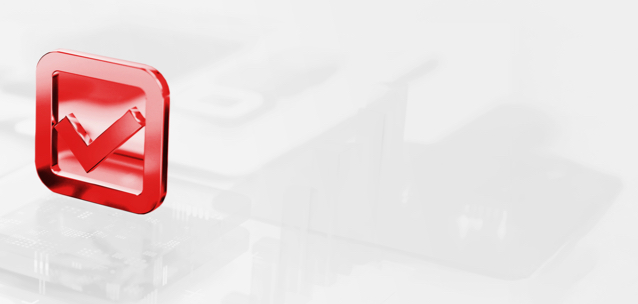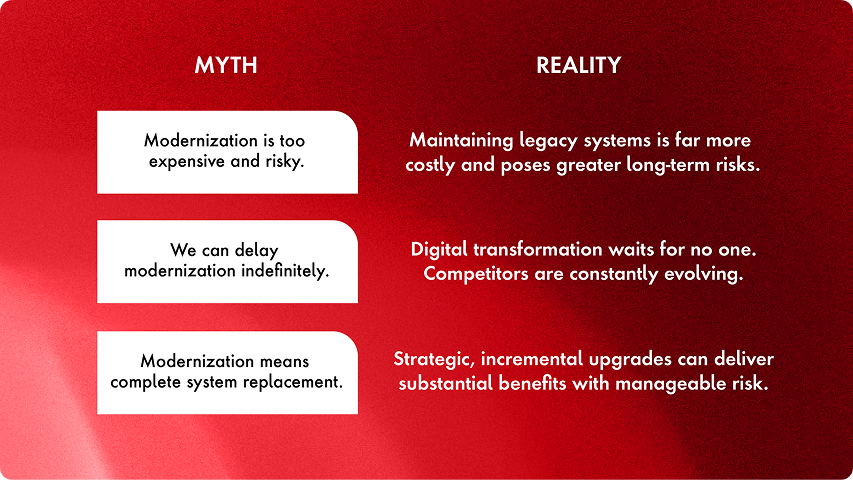What issue can we solve for you?
Type in your prompt above or try one of these suggestions
Suggested Prompt


The ROI of Application Modernization: AI Readiness Checklist for CFOs and Decision Makers
How to turn technical debt into business value with AI-powered app modernization.


Application modernization has become more than just a technical upgrade—it’s a critical business strategy that can make or break an organization’s competitive edge. For CFOs and decision-makers, the conversation around modernization is no longer about whether to invest but how to maximize the return on that investment.
Organizations that rely on outdated systems are not just missing out on efficiency gains; they’re actively increasing operational costs and limiting growth potential.
The aftermath of the COVID-19 pandemic, supply chain disruptions and increasing cybersecurity threats have made clear the necessity of agile, resilient and cost-effective technology infrastructure.
What we've seen in particular coming out of these disruptions is revealing: organizations with legacy systems struggled to scale remote access capabilities, causing productivity bottlenecks when employees needed to work from home. Companies lacking integrated, real-time supply chain systems were unable to quickly pivot suppliers or reroute logistics when disruptions occurred. Businesses with siloed legacy systems couldn't deliver consistent omnichannel experiences when in-person interactions became limited.
The rapid shift to digital operations exposed outdated security protocols, leading to a surge in successful cyberattacks targeting unprepared organizations. Traditional on-premise infrastructure simply couldn't efficiently handle the dramatic fluctuations in digital demand that characterized the pandemic economy.
These crisis-driven revelations have forced organizations to confront a fundamental reality: the true cost of maintaining legacy systems extends far beyond routine maintenance budgets.
Understanding the true cost of legacy systems
Imagine driving an old car that requires constant maintenance, guzzles fuel and can’t keep up with the speed limit. That’s precisely what running outdated legacy systems feels like for businesses today. These systems aren’t just inefficient; they’re financial anchors dragging down your organization’s potential.
The hidden expenses of standing still
Legacy systems may appear to be “working fine,” but they carry a host of hidden costs that impact profitability and long-term sustainability.
Direct financial drain
- Skyrocketing maintenance costs: Legacy systems often require costly patches, specialized skill sets and extensive support contracts to keep them operational.
- Infrastructure inefficiency: Running applications on outdated servers or on-premise environments results in higher energy consumption and real estate costs compared to cloud-native solutions.
- Downtime and productivity losses: System failures, slow performance and integration issues create inefficiencies that impact employee productivity and customer satisfaction.
Costs of stagnation
- Inability to scale: Traditional architectures struggle to support digital expansion, whether through acquisitions, new customer demands or business model shifts.
- Slower innovation: Companies locked into rigid legacy systems find it challenging to integrate AI, automation or real-time analytics—losing ground to more agile competitors.
- Increased cybersecurity vulnerabilities: Legacy applications often lack modern security protocols, making them prime targets for cyberattacks and compliance violations.
Quantifying the ROI: Beyond simple number crunching
Calculating the return on application modernization won’t just be about immediate dollar signs. It’s a multifaceted evaluation that considers both tangible and intangible benefits.
Quantitative metrics to consider
1. Cost savings and efficiency gains
a. Reduced infrastructure, licensing and support costs
b. Decreases in unplanned downtime and related losses
c. Increased operational automation, reducing labor costs
2. Revenue uplift
a. Faster time-to-market for new products and services
b. Enhanced digital customer experience leading to higher retention and conversion rates
c. Improved ability to leverage data for revenue-generating insights
3. Risk mitigation and compliance
a. Reduced exposure to cybersecurity threats
b. Easier compliance with industry regulations
c. Lower likelihood of fines and reputational damage from data breaches
Qualitative benefits that drive value
While harder to measure, these factors significantly impact long-term organizational success:
- Enhanced customer experience: Modern applications support personalized interactions, real-time responsiveness and seamless omnichannel engagement.
- Empowered workforce: Employees benefit from more intuitive, faster and more efficient tools that boost morale and productivity.
- Agility and future-proofing: A modular, cloud-enabled architecture allows businesses to adapt quickly to market shifts without costly overhauls.
Modernization strategies for maximum ROI
Not all modernization approaches deliver equal value. The most effective strategies balance speed, cost and risk while aligning with business objectives.
Incremental vs. full-scale modernization
- Incremental modernization (MVP approach): Prioritizing high-impact areas first, such as customer-facing applications or critical internal systems, to quickly demonstrate value.
- Full-scale modernization: A complete transformation, often necessary when systems are deeply outdated and limiting business growth.
Strategic modernization approaches
- Rehosting (lift and shift): Migrating applications to the cloud without modifying code. Fast and cost-effective but don’t fully leverage cloud-native benefits.
- Re-platforming: Optimizing applications for cloud environments while retaining core functionality.
- Refactoring: Restructuring code to improve efficiency and scalability, allowing for better integration with modern tools and frameworks.
- Replacing: When legacy applications are too outdated, replacing them with new, cloud-native solutions may be the most viable option.
Overcoming common modernization roadblocks
Even with a strong business case, modernization efforts can face resistance, with the resounding, age-old phrase of, “But we’ve always done it this way.” CFOs and decision-makers need to proactively address common barriers:
Myth: Modernization is too expensive and risky.
Reality: Maintaining legacy systems is far more costly and poses greater long-term risks.
Myth: We can delay modernization indefinitely.
Reality: Digital transformation waits for no one. Competitors are constantly evolving.
Myth: Modernization means complete system replacement.
Reality: Strategic, incremental upgrades can deliver substantial benefits with manageable risk.

Two-column infographic titled 'Myth vs Reality' on a red gradient background. Left side lists three myths about modernization; right side presents corresponding realities. Myths include cost, delay and total replacement concerns. Realities emphasize greater legacy risk, competitive urgency, and benefits of incremental upgrades.
The role of change management in successful modernization
The phrase, “But this is how we’ve always done it” is the hallmark of resistance to change—and a major roadblock to modernization efforts. Organizations that fail to address change management often struggle with stalled initiatives, lack of adoption and even outright failure.
Change management is a critical component of any modernization effort. Without executive buy-in and employee alignment, even the best-planned initiatives can fail. According to Gartner, the typical organization has undertaken five major firmwide changes in the past three years—but nearly half of change initiatives fail, with only 34 percent a clear success.
Additionally, 39 percent of employees feel capable of responding to changing business and customer needs. So, where’s the roadblock? Alignment.
Aligning with business objectives
Business leaders must align on the business case for modernization. This includes:
- Demonstrating cost savings through clear financial modeling
- Highlighting competitive risks of maintaining legacy systems
- Showcasing short-term wins through pilot programs or phased rollouts
Employee adoption and training
- Communicate the ‘why’: Clearly explain why modernization is necessary and how it will benefit employees
- Provide continuous learning: Invest in upskilling programs to ensure smooth adoption of new technologies
- Feedback loops: Establish channels for employees input to ensure smooth transitions and improved user experience
Creating a culture of continuous improvement
Modernization is not a one-time project; it’s an ongoing journey. Organizations should:
- Foster a mindset of innovation and agility
- Regularly evaluate technology investments and adjust as needed
- Encourage cross-functional collaboration to maximize business impact
To sustain this continuous evolution, businesses must embrace a culture that prioritizes learning, experimentation and reinvention.
This kind of self-disruption—constantly refining not just products but also the systems and mindsets behind them—is what sets adaptable, future-ready organizations apart.
Financial justification framework
When making the case for application modernization, CTOs and CIOs often partner with CFOs to structure a compelling business case grounded in clear financial logic. The CFO plays a critical role in translating the technical vision into quantifiable value, using a structured financial framework:
1. Current cost analysis
a. Total cost of ownership (TCO) for existing systems
b. Breakdown of maintenance, licensing and infrastructure costs
c. Productivity losses due to inefficiencies
2. Projected investment
a. Estimated modernization costs (tech, training, consulting)
b. Implementation timeline and potential risks
c. Change management and workforce adaptation expenses
3. Expected ROI
a. Direct cost savings and operational efficiencies
b. Revenue impact from improved customer experience and agility
c. Risk reduction and compliance improvements
The role of AI in accelerating modernization
Traditional modernization efforts can take years, but AI-powered solutions are reshaping the landscape. Innovative tools like Sapient Slingshot are revolutionizing how organizations approach modernization and software development. This proprietary AI platform represents a quantum leap in accelerating technological upgrades, offering a compelling solution to the challenges of legacy system transformation.
Slingshot stands out by:
- Leveraging an extensive enterprise code library
- Utilizing advanced generative AI agents
- Providing comprehensive software engineering capabilities
The platform’s most impressive feature is its ability to dramatically compress modernization timelines, potentially reducing time to modernization by 60 to 70 percent. This massive efficiency gain addresses one of the primary concerns for CFOs and decision-makers: the time and resources required for significant technological overhauls.
By blending advanced code generation with agentic AI and a robust code library, Sapient Slingshot enables engineering teams to create high-impact solutions that support everything from initial modernization to ongoing development and testing. It’s not just a tool—it’s a strategic accelerator that transforms the software development lifecycle.
Remember: Your technology strategy is your business strategy. Modernize wisely, invest strategically and leverage cutting-edge AI-powered platforms to create a foundation for sustained innovation and growth.
Conclusion: modernization is an investment, not an expense
For CFOs and decision-makers, application modernization isn’t just about technology—it’s about future-proofing the business. The key is finding the right balance between “keeping the lights on” and driving innovation.
A well-executed modernization strategy delivers measurable cost savings, drives revenue growth, enhances security and positions the organization for long-term success.
Maximize your modernization ROI—explore the Executive Guide for AI-Assisted Software Development.



